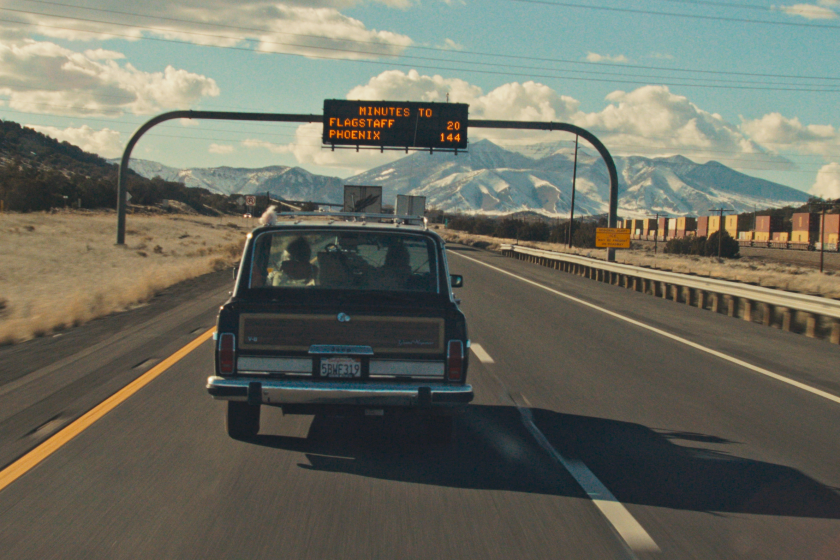On a wing and a prayer
IT is arguably one of the most magnetic moments ever captured on film. This enduring celluloid juncture from 1946’s “It’s a Wonderful Life” can be summoned to mind by merely mentioning “the prayer scene.” In it, a tearfully reduced George Bailey -- played by Jimmy Stewart -- sits at a bar and contemplates taking his own life, then clasps his hands and quietly asks for God’s intervention.
And while filming this key moment, this pivotal point in the picture, Frank Capra goofed -- big time.
Despite a reputation for being fastidiously well prepared, the veteran director had no idea that his star would turn on the waterworks and deliver such an impassioned, intimate performance on the first take. It was something overwhelming even for Stewart himself.
So the cameras rolled, the music and bustle in the bar erupted, and the scene played out -- but when it was over, Capra realized his angle was too distant. And he had failed to capture a close-up of the emotionally draining scene. Capra apologized and asked his Oscar-winning star to replicate it, but a spent Stewart knew he’d nailed it and couldn’t fathom a re-creation as effective as the one he’d just poured out.
To remedy the situation, during postproduction the director and his editor manually and painstakingly moved in -- frame by frame. It created what appears to be an optical zoom.
Luckily for Capra, the result was near perfection.
It’s no mystery why this year the American Film Institute named Capra’s postwar classic “It’s a Wonderful Life” the most inspiring motion picture ever made.
To most, it’s an enriching, sentimental Christmas favorite not to be missed -- almost sacrilege when viewed during any other season.
It’s all the more remarkable that this homespun movie, which was not initially envisioned as a “holiday” film, has become so entrenched in popular culture, such a beloved tradition for families to share.
Oddly enough, the film was unceremoniously released during Christmas week of 1946. Never mind the yuletide flavor, the wintry snowdrifts in Bedford Falls and the holly wreath George Bailey carries slung around his arm -- this Jimmy Stewart-Donna Reed romance was originally scheduled to open in January 1947. But RKO Studios knew it had something special and rushed it into theaters a few weeks early to meet the deadline for Academy Award consideration that year.
Capra shot much of the film on a specially constructed quaint-town set located at RKO’s ranch in the San Fernando Valley -- a site that has long been overtaken by property development. In media interviews at the time, Capra did not portray it as a holiday film. In fact, he said he saw it as a cinematic remedy to combat what he feared was a growing trend toward atheism and to provide hope to the human spirit. In a moment of possible revisionism decades later, Capra said that he also realized that with the holiday season comes an inherent vulnerability in all humans, and that this uplifting tale might just ride on that sentiment.
Without question, however, is the fact that audiences trusted Capra to deliver such patriotisms, all neatly wrapped with a ribbon and bow. Like “Meet John Doe” (1941), about a lie that sparks a political movement. Some critics accused Capra of presenting a “naive” faith in the common man within a syrupy-slick presentation. So skillful in his flair for filmmaking and eliciting emotion, his titles were once called “Capra-corn.”
But the Oscar-winning director has had the last laugh.
“It’s a Wonderful Life” keeps popping its way back into homes on television, in commercials, on DVD, routinely broadcast twice each season on NBC. (It’s being broadcast Sunday night.)
Capra, an Italian-born filmmaker who gave us such early classics as “It Happened One Night” and “Mr. Smith Goes to Washington,” died in 1991, but not before witnessing “It’s a Wonderful Life” take on iconic wings of sort when television began airing it regularly in the 1970s.
The movie transcended time and soared well beyond his imagination.
“It’s the damnedest thing I’ve ever seen,” Capra told the Wall Street Journal in 1984. “The film has a life of its own now and I can look at it like I had nothing to do with it. I’m like a parent whose kid grows up to be president. I’m proud ... but it’s the kid who did the work. I didn’t even think of it as a Christmas story when I first ran across it. I just liked the idea.”
In probably his best-loved role, and a dark one at that, Stewart plays selfless everyman George Bailey through a tumultuous timeline that climaxes in near suicide on Christmas Eve. In answer to his desperate prayer at the bar, George is rescued by an unlikely angel with a smiling marshmallow face -- a little fellow named Clarence -- who convinces him that life is precious and that each man’s life touches another with untold influence.
“I think, as the story unfolds,” Stewart explained years ago, “it becomes clear that the movie is about hope, love and friendship.”
There has been no shortage of fans of that message over the years, including director Steven Spielberg, who once said: “ ‘It’s a Wonderful Life’ shows that every human being on this Earth matters -- and that’s a very powerful message.”
The actress and comedian Carol Burnett once said of the prayer scene: “That scene is one of the finest pieces of work that anyone has ever done on the screen. That moment, at that bar, it’s indelible in my mind. He realized that he has lost everything. The money is missing. It’s Christmas Eve. And he sits there and starts to cry. He is so in tune with that character and that writing that he and George Bailey are one.”
As holiday classics go, “It’s a Wonderful Life” has become the American version of Charles Dickens’ “A Christmas Carol.” Scrooge is portrayed in the form of blowhard heavy Henry Potter (the great Lionel Barrymore); Clarence the Angel (Henry Travers) can be considered the ghostly visitor who illustrates to George what life would have been like without him; and Zuzu Bailey (Karolyn Grimes) is a more sprite version of Tiny Tim, casting cheer into the night as the story comes to a triumphant close.
It’s interesting to note that James Maitland Stewart, who died in 1997 at age 89, was indeed a man of faith, a practicing Presbyterian, and himself a firm believer in heavenly help, as his grave marker in Glendale’s Forest Lawn cemetery attests: “For He shall give His angels charge over thee to keep thee in all thy ways.”
According to his daughter, Kelly Stewart Harcourt, that engraved passage from Scripture was something Stewart’s father had pointed out to him when the young actor went off to war and served as a fighter pilot.
One who reaffirms this very message and other bits of wisdom found sewn in the movie is Grimes, now 66, who portrayed the little tyke who asks her daddy to repair her fallen rose petals. Today, Grimes travels the country making personal appearances, tends to her website (www.zuzu.net) and greets enthusiastic fans at nostalgia shows and screenings of the movie. She has no idea how many times she’s written out her most famous line on photos and Christmas ornaments: “Every time a bell rings, an angel gets his wings.”
Having appeared in another Christmas classic, “The Bishop’s Wife” starring Cary Grant, this time of year is obviously Grimes’ busy season (see related story, page 19).
“There have been adverse things happen in my own life,” she said, “but there are balances out there. And the movie itself has affected my life so much because I have George Bailey’s philosophy ... that friendships and caring and loving will carry you through anything.”
Produced on a relatively small budget of $3 million, “It’s a Wonderful Life” was generally heralded by American critics while the British found it to be bloody awful. Over time, the tale evolved into a brilliant holiday gem for American moviegoers, a sparkling ornament.
Even with its naysayers and flaws -- and yes there are a few snags -- all is forgiven by the time the opening chorus of “Auld Lang Syne” begins. Be sure to hang on to the last seconds. In the finale, you can spot Zuzu attempting to fake the lyrics to “Auld Lang Syne.”
“If you watch closely,” Grimes says of her most embarrassing film moment, “Jimmy Stewart is holding me tightly and he looks at me and begins to laugh because he knows I’m not singing the right words.”
*
Cox is author of “It’s a Wonderful Life: A Memory Book.”
*
(BEGIN TEXT OF INFOBOX)
--
There’s some ‘Wonderful’ tidbits
--
As “It’s A Wonderful Life” enjoys its 60th anniversary, here are some little-known facts about the movie.
Horror film star Vincent Price was originally considered to play the miserable Mr. Potter.
*
A method of manufacturing convincingly crunchy snow was developed specifically for this film. Ingredients included a mixture of fireman’s foamite, soap, water and plaster, shot through pressure hoses and layered with wind machines.
*
Soprano Adriana Caselotti (the voice of Walt Disney’s Snow White) can be seen and heard in the background during George Bailey’s prayer scene inside Martini’s bar.
*
W.C. Fields was considered for the role of forgetful Uncle Billy.
*
“It’s a Wonderful Life” was based on a short story titled “The Greatest Gift,” written by Civil War historian Philip Van Doren Stern, in 1938.
*
Next to playing old man Gower, actor H.B. Warner’s most famous role was that of Christ in the 1927 silent version of “The King of Kings,” directed by Cecil B. DeMille.
*
Watch in the office scenes for Jimmy the Raven, a trained black bird who also appeared (as a crow) in the film “The Wizard of Oz,” landing on the Scarecrow’s head.
*
It’s just urban legend that the characters of Ernie the cabdriver and Bert the cop were the inspiration behind the names of Jim Henson’s famous pair of “Sesame Street” pals.
*
--STEPHEN COX
*
‘It’s a Wonderful Life’
Where: NBC
When: 8 p.m. Sunday
More to Read
Only good movies
Get the Indie Focus newsletter, Mark Olsen's weekly guide to the world of cinema.
You may occasionally receive promotional content from the Los Angeles Times.










